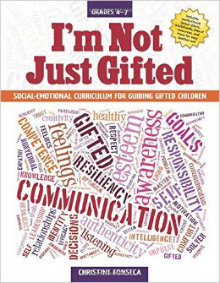Social-Emotional Learning & Gifted Middle Graders
I’m Not Just Gifted: Social-Emotional Curriculum for Guiding Gifted Children
By Christine Fonseca
(Prufrock Press, 2015 – Learn more)
Reviewed by Deb Hubble


As educators, we should ALL be committed to ensuring that gifted students find a place in the world without “sacrificing their cognitive prowess,” the author asserts.
Aimed especially at teachers of gifted students in grades four through seven, the book is comprised of two sections: the first gives an overview of essential understanding about gifted students, and the second offers a social-emotional curriculum for guiding gifted students. The curriculum is divided into five units with four to eleven lessons each.
A grounding in research
In Section One, Christine Fonseca reviews the research on social-emotional traits of intellectually gifted children. These traits include holding themselves to (often impossibly) high standards, possessing internal motivation, experiencing emotional intensity with extreme highs and lows, having strong levels of empathy/social concern, showing moral maturity even in the face of peer pressure, desiring self-actualization at early ages, and displaying resiliency. With these traits, Fonseca asserts, this student group needs specific curriculum to help them navigate their feelings, social development, and emotional intelligence.
The curriculum described in the book has its roots in positive psychology, linking emotions and their influence to thinking and behavior, and promoting optimism and mental wellness. The author cites research declaring that “emotional intelligence, even more than cognitive ability, influences academic performance.” It is as if, without such social-emotional instruction, these highly gifted students may somehow lose their apparent advantage over other students of average intellect.
Ready-to-use lessons
Fonseca’s book is easy to read within an hour or two; once the theoretical basis has been laid, the book is truly a collection of lessons complete with ready-to-use lesson plans, worksheets, lists of resources, and web links. Ideally, this curriculum is delivered to homogeneous groups of like-aged gifted students, in thirty minute chunks.
The best format would be discussion group-based, with students frequently working in pairs, triads, or quads; instructional focus is both on process and product. Strategies suggested in the book range from bibliotherapy, to the use of biographies of gifted individuals, to videotherapy and the visual and performing arts.
Each lesson includes ideas for extensions and enrichment opportunities, and each is aligned to the standards of the State Learning Standards to Advance Social and Emotional Learning, the National Association of Gifted Children, and the Common Core State Standards.
The five units of the curriculum are made up of forty-five individual lessons.
• Unit One focuses on the definition of giftedness and explores the inherent expectations related to “gifted” labels.
• Unit Two is about emotional intelligence: self-awareness, managing emotions, conflict resolution.
• Unit Three covers the development of social-emotional skills such as optimism, positive self-talk, motivation, responsibility, stress management, and decision-making skills.
• Unit Four is all about resiliency – adaptability, relationships, and communication and leadership skills.
• Unit Five contains lessons related to talent development: goal-setting, cultivation of talents and passions, learning styles, and career guidance.
Taking the book beyond gifted classes
Teachers in self-contained gifted classrooms or counselors able to pull gifted students on a regular basis can best benefit from this book and its suggested curriculum. As one can see, however, ALL students would greatly benefit from instruction related to social-emotional development. Which students DON’T need adult guidance on matters like self-awareness, goal-setting, conflict resolution, and managing emotions? Even used sporadically, the lessons in this book would be valuable in building classroom community and individual responsibility with ANY groups of middle grades students.
Especially to build awareness of the unique needs of gifted students, but also to enrich the education provided to ALL students in schools today, this book is a welcome resource to any teacher determined to make education relevant and meaningful to this generation.
Deb Hubble is an elementary principal in a large suburban Houston school district, Katy ISD. Previous educational roles include special education teacher, librarian, district Language Arts curriculum coordinator, campus-based literacy coach, writer of abstracts for Effective Schools, and published author for Corwin Press. While her work experience has been at the elementary level, Deb lives with her husband and four teenagers, making her something of an expert on matters related to middle school. She can be found on Twitter @Debhubble1.



































